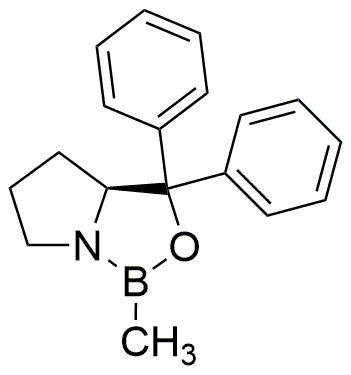(S)-5,5-Diphenyl-2-methyl-3,4-propano-1,3,2-oxazaborolidine is widely utilized in research focused on:
- Asymmetric Synthesis: This compound serves as a chiral catalyst in asymmetric synthesis, enabling the production of enantiomerically pure compounds, which is crucial in pharmaceuticals for ensuring efficacy and safety.
- Drug Development: It plays a significant role in drug discovery, particularly in the development of new therapeutic agents, by facilitating the formation of complex organic molecules that can lead to novel treatments.
- Material Science: The compound is used in the creation of advanced materials, such as polymers and coatings, that require specific properties like durability and resistance to environmental factors.
- Organic Electronics: It finds applications in the field of organic electronics, particularly in the development of organic light-emitting diodes (OLEDs) and organic photovoltaic cells, enhancing performance and efficiency.
- Catalysis: This chemical is utilized as a catalyst in various chemical reactions, providing advantages such as higher reaction rates and selectivity compared to traditional catalysts, which can lead to more efficient manufacturing processes.
General Information
Properties
Safety and Regulations
Applications
(S)-5,5-Diphenyl-2-methyl-3,4-propano-1,3,2-oxazaborolidine is widely utilized in research focused on:
- Asymmetric Synthesis: This compound serves as a chiral catalyst in asymmetric synthesis, enabling the production of enantiomerically pure compounds, which is crucial in pharmaceuticals for ensuring efficacy and safety.
- Drug Development: It plays a significant role in drug discovery, particularly in the development of new therapeutic agents, by facilitating the formation of complex organic molecules that can lead to novel treatments.
- Material Science: The compound is used in the creation of advanced materials, such as polymers and coatings, that require specific properties like durability and resistance to environmental factors.
- Organic Electronics: It finds applications in the field of organic electronics, particularly in the development of organic light-emitting diodes (OLEDs) and organic photovoltaic cells, enhancing performance and efficiency.
- Catalysis: This chemical is utilized as a catalyst in various chemical reactions, providing advantages such as higher reaction rates and selectivity compared to traditional catalysts, which can lead to more efficient manufacturing processes.
Documents
Safety Data Sheets (SDS)
The SDS provides comprehensive safety information on handling, storage, and disposal of the product.
Product Specification (PS)
The PS provides a comprehensive breakdown of the product’s properties, including chemical composition, physical state, purity, and storage requirements. It also details acceptable quality ranges and the product's intended applications.
Certificates of Analysis (COA)
Search for Certificates of Analysis (COA) by entering the products Lot Number. Lot and Batch Numbers can be found on a product’s label following the words ‘Lot’ or ‘Batch’.
*Catalog Number
*Lot Number
Certificates Of Origin (COO)
This COO confirms the country where the product was manufactured, and also details the materials and components used in it and whether it is derived from natural, synthetic, or other specific sources. This certificate may be required for customs, trade, and regulatory compliance.
*Catalog Number
*Lot Number
Safety Data Sheets (SDS)
The SDS provides comprehensive safety information on handling, storage, and disposal of the product.
DownloadProduct Specification (PS)
The PS provides a comprehensive breakdown of the product’s properties, including chemical composition, physical state, purity, and storage requirements. It also details acceptable quality ranges and the product's intended applications.
DownloadCertificates of Analysis (COA)
Search for Certificates of Analysis (COA) by entering the products Lot Number. Lot and Batch Numbers can be found on a product’s label following the words ‘Lot’ or ‘Batch’.
*Catalog Number
*Lot Number
Certificates Of Origin (COO)
This COO confirms the country where the product was manufactured, and also details the materials and components used in it and whether it is derived from natural, synthetic, or other specific sources. This certificate may be required for customs, trade, and regulatory compliance.


